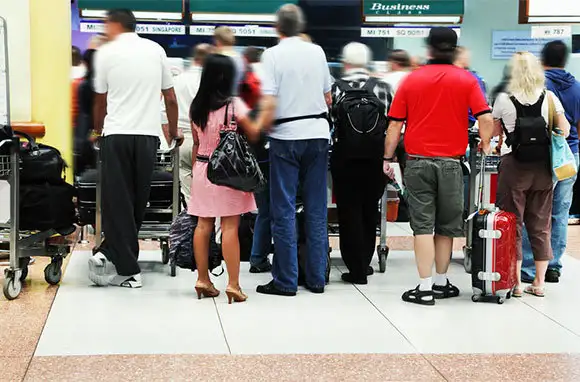
The U.S. has some of the world’s busiest airports: In fact, 12 of the world’s top 30 were in the U.S. in 2012. But busy airports aren’t necessarily good ones, and big doesn’t mean user-friendly. (None of the top-10 U.S. airports earned an Airline Service Quality award from Airports Council International.) Still, you’ll probably have to cope with at least one of these monsters—and sometimes two—on an upcoming trip. So knowing helps.
This report is written from the standpoint of a visitor unfamiliar with each airport and does not include some of the special gimmicks regular travelers or residents might use. The most widely used airport-traffic data measure the sum of deplaned, enplaned, and direct-transfer passengers, and the numbers for each major airline include passengers flown by affiliated regional carriers.
Data were pulled from the Bureau of Transportation Statistics and represent the 12-month period from July 2012 to June 2013.
Image Gallery
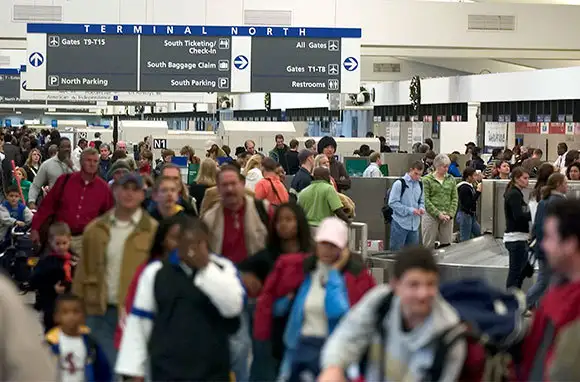
Hartsfield-Jackson Atlanta International Airport (ATL)
Ranking: Number one in the world and in the U.S., with 95.5 million passengers.
Location: Ten miles south of the city center, with extensive nearby hotel accommodations.
Major Airlines: Hartsfield-Jackson is Delta's largest hub, and Delta carries about 77 percent of the airport's total passengers. AirTran (plus Southwest) operates a much smaller hub, with 15 percent of the flights. Most big domestic airlines (except JetBlue) have a few flights. International flights are mainly on Delta and SkyTeam partners.
Layout: The field has five parallel runways, providing one of the highest capacities in the U.S. Passenger facilities consist of a series of six parallel midfield concourses plus a separate international terminal, connected by an underground people mover. Hubbing does not require passing through security again: Almost all gates and the people mover are inside a single air-side security zone.
Performance: 80 percent of departures and 82 percent of arrivals are on time, the average departure delay is 55 minutes and arrival delay is 62 minutes, and cancellations are at 0.9 percent.
Ground Transportation: Heavy-rail system Marta serves the airport with frequent trains to the city center ($2.50). The flat-rate taxi fare is $30–$32 to the city center. Numerous shuttles serve the city and surrounding areas. Rental cars are centralized in a single area, connected to the airport by a people mover.
Alternate Regional Airports: None.

Hartsfield-Jackson Atlanta International Airport (ATL)
Ranking: Number one in the world and in the U.S., with 95.5 million passengers.
Location: Ten miles south of the city center, with extensive nearby hotel accommodations.
Major Airlines: Hartsfield-Jackson is Delta's largest hub, and Delta carries about 77 percent of the airport's total passengers. AirTran (plus Southwest) operates a much smaller hub, with 15 percent of the flights. Most big domestic airlines (except JetBlue) have a few flights. International flights are mainly on Delta and SkyTeam partners.
Layout: The field has five parallel runways, providing one of the highest capacities in the U.S. Passenger facilities consist of a series of six parallel midfield concourses plus a separate international terminal, connected by an underground people mover. Hubbing does not require passing through security again: Almost all gates and the people mover are inside a single air-side security zone.
Performance: 80 percent of departures and 82 percent of arrivals are on time, the average departure delay is 55 minutes and arrival delay is 62 minutes, and cancellations are at 0.9 percent.
Ground Transportation: Heavy-rail system Marta serves the airport with frequent trains to the city center ($2.50). The flat-rate taxi fare is $30–$32 to the city center. Numerous shuttles serve the city and surrounding areas. Rental cars are centralized in a single area, connected to the airport by a people mover.
Alternate Regional Airports: None.
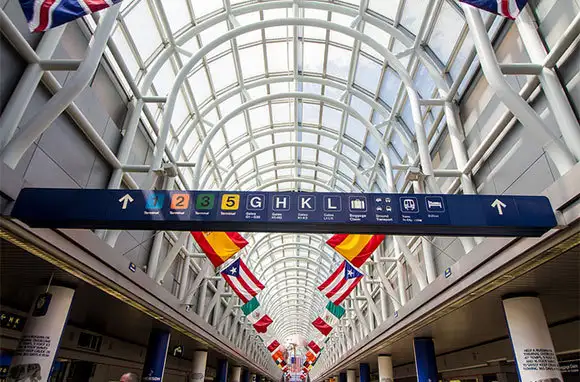
O'Hare International Airport (ORD)
Ranking: Number two in the U.S. and number five in the world, with 67.1 million passengers.
Location: Eighteen miles northwest of the Loop, with extensive nearby hotel accommodations.
Major Airlines: O'Hare is the only U.S. airport that serves as a major hub for two giant airlines: United, with about 40 percent of the airport's passengers, and American, with about 34 percent. Most other big domestic airlines (except Southwest) serve O'Hare, along with many Oneworld and Star Alliance international members.
Layout: The field has seven runways in three parallel sets, some intersecting; O'Hare is in the process of reconfiguring the field to six parallel runways to increase capacity. Passenger facilities consist of three contiguous domestic terminals plus a distant international terminal, connected by a people mover outside of security. Interline connections can be difficult.
Performance: 71 percent of departures and 74 percent of arrivals are on time, the average departure delay is 61 minutes and arrival delay is 71 minutes, and cancellations are at 2.9 percent.
Ground Transportation: Heavy-rail system CTA "L", with an on-site station accessible by walking from three domestic terminals, serves O'Hare with frequent Blue Line trains to the Loop ($5). The people mover plus a shuttle bus connect to a stop on suburban heavy-rail Metra's North Central Service line, with trains to downtown Chicago ($4.75) and to northern suburbs through Antioch. Taxi fares to the city center are $30–$40. Several shuttles serve the city and surrounding areas. A consolidated car-rental facility served by the people mover is under construction.
Alternate Regional Airports: Chicago Midway International Airport (MDW), southwest of the Loop and closer than O'Hare, is Southwest's main base in Chicago; Southwest (with AirTran) accounts for almost 95 percent of Midway's 17 million annual passengers. The CTA Orange Line serves Midway. Chicago Rockford International Airport (RFD), some 45 miles northwest of the Loop, is Allegiant's main gateway to Chicago, with a few seasonal Frontier flights. Although relatively close, Gary/Chicago International Airport (GYY), 25 miles east of the Loop, currently has no scheduled service.
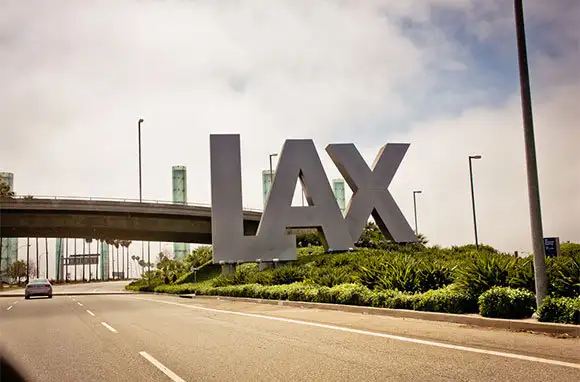
Los Angeles International Airport (LAX)
Ranking: Number three in the U.S. and number six in the world, with 63.7 million passengers.
Location: Eighteen miles southwest of central Los Angeles, with extensive nearby hotel accommodations.
Major Airlines: No single airline dominates LAX, which is a featured destination for Alaska Airlines, American, Delta, Southwest, and United. All other large domestic lines also serve LAX, which is an important Pacific gateway and is served by major international lines in all three alliances: Oneworld, SkyTeam, and Star Alliance.
Layout: The landing field has four parallel runways. Passenger facilities are in nine separate terminals. Terminals 5 (Delta), 6 (Alaska, United), and 7 and 8 (United) are connected by airside walkways; all other interterminal transfers require exiting and reentering security—a major hassle for interline connections. LAX has no people movers.
Performance: 81 percent of departures and 79 percent of arrivals are on time, the average departure delay is 45 minutes and arrival delay is 53 minutes, and cancellations are at 1.1 percent.
Ground Transportation: The rail connection is poor: A shuttle bus connects to a light-rail line that doesn't go downtown, although plans call for a future light-rail line that goes directly to the airport. Taxi fares are meter plus a $4 surcharge. Prime Time Shuttle and SuperShuttle operate vans throughout the large Southern California metropolitan area (around $15 to downtown Los Angeles or Beverly Hills). Major car-rental shuttles pick up on the lower arrivals level; others pick up at a consolidated facility connected to the airport by a shuttle bus.
Alternate Regional Airports: The greater Southern California metro area is served by five other airports. Burbank's Bob Hope Airport (BUR) is more convenient for Burbank, Glendale, Pasadena, and much of the San Fernando Valley, with a mix of regional and long-haul flights. Long Beach Airport (LGB) is convenient to San Pedro, Palos Verde, and several beach communities and is an important hub for JetBlue. Orange County's John Wayne Airport (SNA) is the airport of choice for visitors to Anaheim's Disneyland, with mostly regional flights. LA/Ontario International Airport (ONT) mainly serves the Southern California's Inland Empire region in Riverside and San Bernardino counties with a mix of long- and short-haul flights. LA/Palmdale Regional Airport (PMD) currently has no scheduled service but promises future growth.
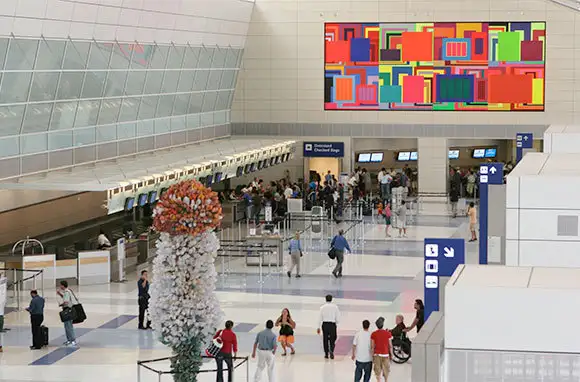
Dallas/Fort Worth International Airport (DFW)
Ranking: Number four in the U.S. and number eight in the world, with 58.6 million passengers.
Location: Twenty miles northwest of central Dallas and 28 miles northeast of central Fort Worth, with one hotel within the terminal complex and some other nearby hotel accommodations.
Major Airlines: Dallas/Fort Worth is American Airlines' most important hub, and the airline handles 82 percent of the airport's passengers. Most other large domestic lines serve the airport, including (recently) a few flights on Southwest, along with American's international partners in the Oneworld alliance.
Layout: The airfield has five parallel runways plus two parallels on a different orientation. Passenger facilities are in five separate terminals connected by a people mover inside security. Connections are painless, although some involve long walks.
Performance: 74 percent of departures and 78 percent of arrivals are on time, the average departure delay is 53 minutes and arrival delay is 63 minutes, and cancellations are at 1.8 percent.
Ground Transportation: Rail access is inconvenient: A shuttle bus connects to an infrequent heavy-rail commuter system with no Sunday service ($2.50 to downtown Dallas or Fort Worth). A light-rail connection that will run from central Dallas to the terminals is being planned. Taxi flat rates are $40 to Dallas and $43 to Fort Worth, plus airport charges. Go Yellow Checker Shuttle charges $15 to downtown Dallas and $19 to Fort Worth. Rental cars are concentrated at a combined facility that is reachable from the airport by shuttle bus.
Alternate Regional Airports: Dallas Love Field (DAL), much closer to central Dallas, is one of Southwest's main bases; a few other lines operate there as well. Restrictions on long-haul use of the field are slowly being phased out.
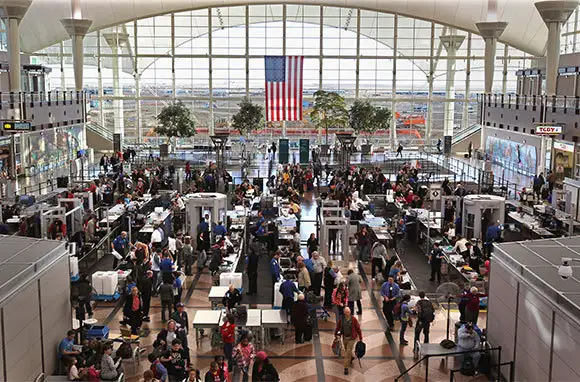
Denver International Airport (DEN)
Ranking: Number five in the U.S. and number 13 in the world, with 53.2 million passengers.
Location: Twenty-four miles northeast of the city center, with very limited nearby hotel accommodations.
Major Airlines: Denver International is a longtime hub for United, which currently handles about 33 percent of the airport's traffic. It's also an important point for Southwest, with 25 percent of the traffic, and the main base for Frontier, with 18 percent. Most other large lines serve Denver International, but international service is mainly to Canada and Mexico, with a few flights to Europe and one new nonstop to Tokyo.
Layout: The airfield has four parallel runways and two crossed parallels. Passenger facilities consist of three parallel midfield concourses plus a terminal, all connected by a people mover inside security. Connections are easy.
Performance: 75 percent of departures and 79 percent of arrivals are on time, the average departure delay is 51 minutes and arrival delay is 55 minutes, and cancellations are at 1.2 percent.
Ground Transportation: Currently, Denver International has no rail service, although a commuter line is under construction. Taxi flat rates are $55 to downtown Denver and $88 to Boulder. A handful of shuttles serve downtown Denver as well as other communities in the region. SuperShuttle charges $22 to get downtown. Direct shuttle and bus services are also available to regional winter-sports centers.
Alternate Regional Airports: None.
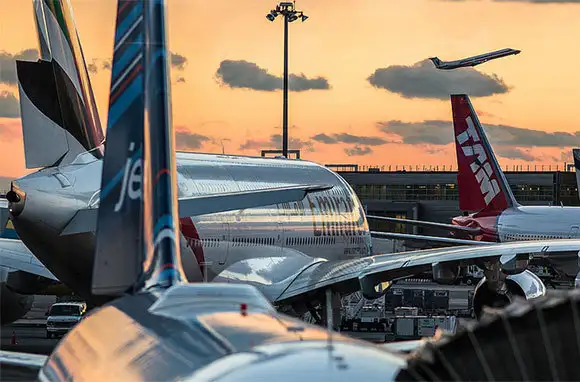
John F. Kennedy International Airport (JFK)
Ranking: Number six in the U.S. and number 17 in the world, with 49.3 million passengers.
Location: Fifteen miles southeast of midtown Manhattan, with limited nearby hotel accommodations.
Major Airlines: JFK is the country's main international gateway, served by most transatlantic lines and many transpacific and Latin American lines. Although no line dominates traffic, JFK is JetBlue's major hub, with 38 percent of total traffic, and an increasingly important center for Delta, at 23 percent, and American, at 17 percent. Conspicuously missing is United, whose flights are limited to Los Angeles, San Francisco, and Washington.
Layout: The airfield has two sets of parallel runways at differing orientations—a configuration that limits capacity at peak times. Passenger facilities consist of six terminals, with Terminals 2 and 4 consolidated by Delta and the others connected only by the AirTrain people mover, which is free within the airport but is outside of security. A connection requiring a change of terminals is a major hassle.
Performance: 76 percent of departures and 74 percent of arrivals are on time, the average departure delay is 67 minutes and arrival delay is 66 minutes, and cancellations are at 2.5 percent.
Ground Transportation: For $5, the AirTrain people mover connects each terminal with a subway stop: either the Howard Beach stop, for a connection to the New York City Subway ($2.50), or the Jamaica Station stop, for a connection to the Long Island Rail Road ($7.00). Trains from Jamaica Station also serve Long Island communities to the east. The taxi flat fare to Manhattan is $52 plus tolls. Lots of shuttles operate with service to Manhattan as well as communities in the region; SuperShuttle charges $19 from JFK to Midtown.
Alternate Regional Airports: The New York metro area is served by four other airports. LaGuardia Airport (LGA) is closer to Manhattan than JFK, but service is limited to short- and medium-haul trips, on which LGA carries more passengers than JFK. Newark Liberty International Airport (EWR) is 15 miles from Midtown, and it's the main New York-area gateway for United, with extensive domestic and international service. Long Island MacArthur Airport (ISP) is 51 miles east of Midtown and the main New York gateway for Southwest and Allegiant. White Plains' Westchester County Airport (HPN) is 34 miles north of Midtown and provides limited short-haul service to important eastern and midwestern centers. Stewart International Airport (SWF) is 66 miles north of central Manhattan and was taken over by the Port Authority as a possible relief airport for JFK and EWR. However, its distance and lousy access have so far limited flights to regional feeds plus JetBlue flights to Florida.
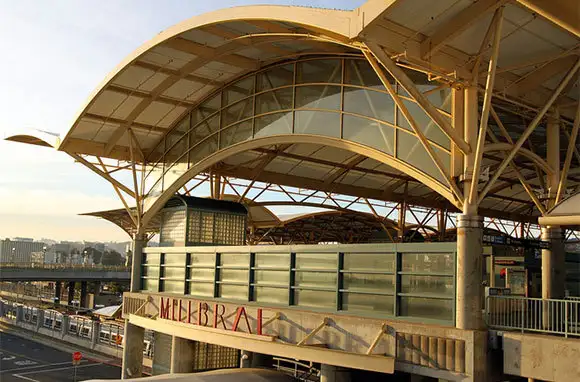
San Francisco International Airport (SFO)
Ranking: Number seven in the U.S. and number 22 in the world, with 44.4 million passengers.
Location: Fourteen miles south of the city center, with extensive nearby hotel accommodations.
Major Airlines: SFO is United's main West Coast hub and Asian gateway, with 49 percent of the airport's total traffic, but most other big lines maintain a substantial presence.
Layout: The airfield has two sets of parallel runways at different orientations; parallels are too close together to permit simultaneous use for instrument landings. Passenger facilities consist of six contiguous terminals, but most terminal-to-terminal access requires exiting and reentering security. A people mover outside of security connects all terminals, connects to the BART station, and provides access to some parking lots.
Performance: 74 percent of departures and 70 percent of arrivals are on time, the average departure delay is 63 minutes and arrival delay is 68 minutes, and cancellations are at 2.4 percent.
Ground Transportation: Bay Area Rapid Transit (BART) trains run from the airport station to downtown San Francisco ($8.25; $3.05 for seniors), to the East Bay, and to the nearby Millbrae Caltrain station for commuter trains down the Peninsula. The metered taxi fare from the airport to downtown San Francisco is about $45. Numerous shuttles serve downtown and many other Bay Area communities; most shuttles charge $17 to get downtown.
Alternate Regional Airports: Three other airports serve the Bay Area. Oakland International Airport (OAK), about 20 miles east of San Francisco, is the airport of choice for many East Bay communities; it's also a big center for low-cost flights. Norman Y. Mineta San Jose International Airport (SJC), about 47 miles south of San Francisco, is the airport of choice for much of Silicon Valley, with lots of regional service and some long-haul flights. Charles M. Schulz-Sonoma County Airport (STS)—yes, it's named for the Peanuts guy—is about 65 miles north of San Francisco; it is convenient to Marin, Napa, and Sonoma counties and provides limited flights to Los Angeles, Portland, San Diego, and Seattle.
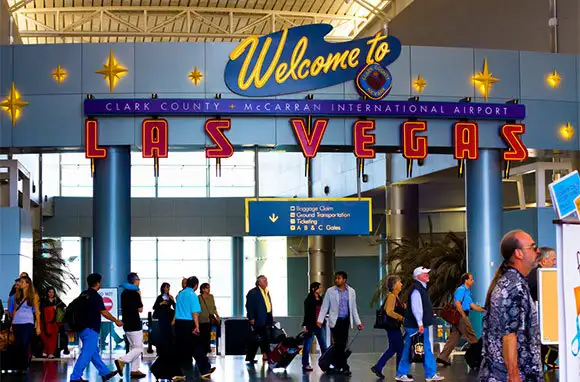
McCarran International Airport (LAS)
Ranking: Number eight in the U.S. and number 23 in the world, with 41.7 million passengers.
Location: Two to four miles southwest of most top hotels on the Strip, with some closer accommodations.
Major Airlines: No single airline dominates McCarran: Southwest comes close, at 44 percent of the airport's total traffic, but other large domestic lines and a few big foreign lines are represented. McCarran is the major focus destination for Allegiant.
Layout: The airfield has three runways: two parallel and a third with a different orientation. Passenger facilities consist of two terminals: a larger all-domestic terminal, and a smaller terminal not connected inside security with all international and some domestic flights.
Performance: 79 percent of departures and 82 percent of arrivals are on time, the average departure delay is 52 minutes and arrival delay is 50 minutes, and cancellations are at 0.6 percent.
Ground Transportation: McCarran has no rail access. Metered taxi fares to major hotels on the Strip cost approximately $12–$20. Beware of taxis that leave from the airport's south entrance—they are taking you for a ride. A consolidated car-rental center is three miles from the terminal and is accessed by shuttle bus. Numerous shuttles serve most major hotels; fares are $7–$10.
Alternate Regional Airports: None.
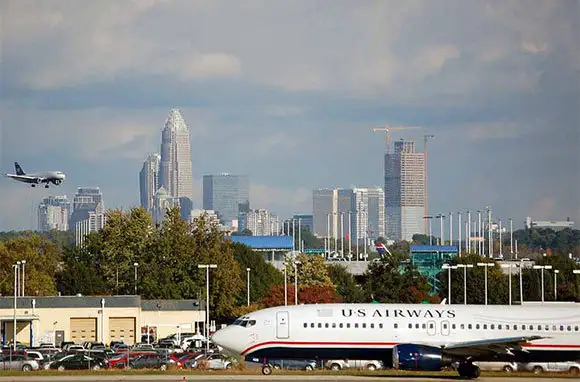
Charlotte Douglas International Airport (CLT)
Ranking: Number nine in the U.S. and number 24 in the world, with 41.2 million passengers.
Location: About seven miles west of the city center, with numerous nearby hotel accommodations.
Major Airlines: Charlotte Douglas is the main hub for US Airways, with about 71 percent of the airport's total passengers. Most other big lines operate flights from Charlotte Douglas to their hubs. Presently, Charlotte Douglas' main international services are on Star Alliance partners, chiefly Lufthansa, but the probable merger with American will likely bring a big shift.
Layout: The airfield has three parallel runways and one at a different orientation. Passenger facilities are concentrated into a single large terminal. Easy all-inside security connections may involve long walks.
Performance: 83 percent of departures and 82 percent of arrivals are on time, the average departure delay is 58 minutes and arrival delay is 49 minutes, and cancellations are at 1.2 percent.
Ground Transportation: Charlotte Douglas has no rail access, but express bus service reaches downtown in about 25 minutes ($2). The metered taxi fare downtown is about $25. Numerous shuttles serve downtown (about $22) and surrounding communities.
Alternate Regional Airports: Allegiant recently started service to Concord Regional Airport (JQF), about 30 miles northeast of Charlotte, with flights to Orlando.
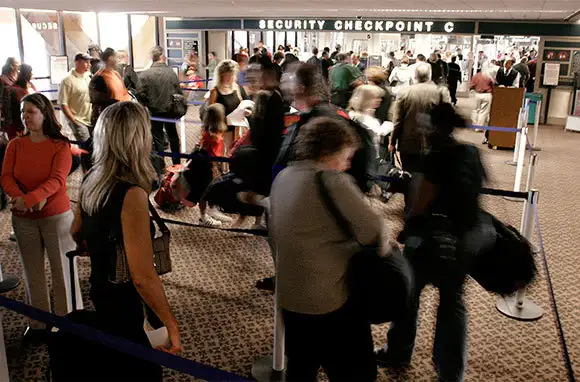
Phoenix Sky Harbor International Airport (PHX)
Ranking: Number 10 in the U.S. and number 25 in the world, with 40.5 million passengers.
Location: About five miles east of the city center, with limited hotel accommodations in the immediate vicinity.
Major Airlines: PHX is the major western hub for US Airways, with almost half of the airport's traffic, but Southwest is also big, at 33 percent. Most other major lines fly to nearby hubs. International service is mainly to Mexico, with a few flights to Canada and Europe.
Layout: The airfield has three parallel runways. Passenger facilities are in three separate terminals, with no interterminal access inside security; connections to different airlines can be a hassle. Shuttle buses connect the terminals, and a people mover is in the works.
Performance: 84 percent of departures and 86 percent of arrivals are on time, the average departure delay is 47 minutes and arrival delay is 48 minutes, and cancellations are at 0.6 percent.
Ground Transportation: The Sky Train people mover connects Terminal 4 with the light-rail Metro system, which runs downtown, to the north, and to Mesa ($2). The minimum airport taxi fare is $16, which probably covers trips downtown; Yellow Cab has a flat rate of $15 for trips within eight miles of the airport. SuperShuttle serves communities throughout the valley; the rate downtown is $14 for the first passenger and $7 for each additional passenger. Car rentals are consolidated at a single facility, which is reachable by shuttle bus.
Alternate Regional Airports: Phoenix-Mesa Gateway Airport (AZA) is about 32 miles east of downtown Phoenix and is the main area gateway for Allegiant and Spirit, but Spirit is moving to PHX this month.
More From Smartertravel:
We hand-pick everything we recommend and select items through testing and reviews. Some products are sent to us free of charge with no incentive to offer a favorable review. We offer our unbiased opinions and do not accept compensation to review products. All items are in stock and prices are accurate at the time of publication. If you buy something through our links, we may earn a commission.
Related
Top Fares From
Today's Top Travel Deals
Brought to you by ShermansTravel
Kenya: 14-Night Tour, Incl. Tanzania &...
smarTours
 vacation
$7125+
vacation
$7125+
7-Night Bermuda Cruise From Round-Trip Cruise...
Norwegian Cruise Line
 cruise
$1036+
cruise
$1036+
Ohio: Daily Car Rentals from Cincinnati
85OFF.com
 Car Rental
$19+
Car Rental
$19+



